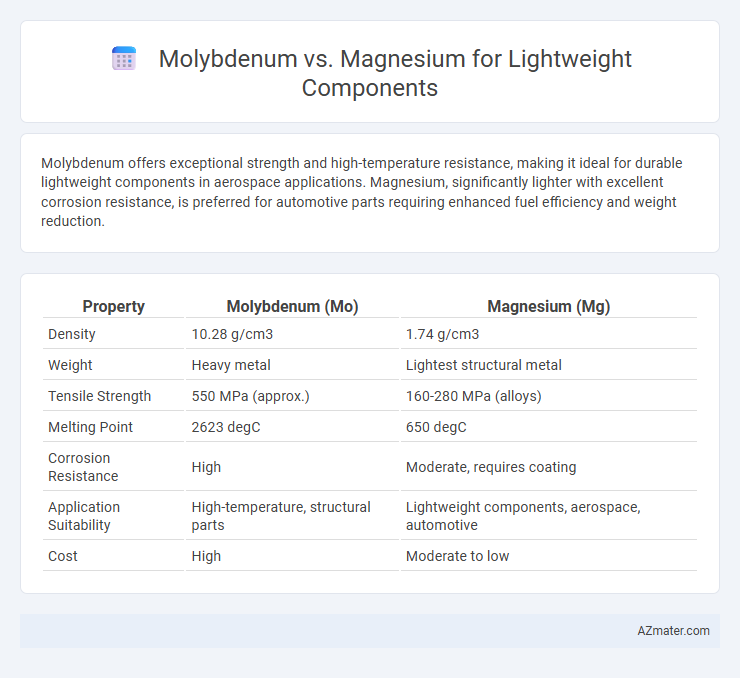Molybdenum offers exceptional strength and high-temperature resistance, making it ideal for durable lightweight components in aerospace applications. Magnesium, significantly lighter with excellent corrosion resistance, is preferred for automotive parts requiring enhanced fuel efficiency and weight reduction.
Table of Comparison
| Property | Molybdenum (Mo) | Magnesium (Mg) |
|---|---|---|
| Density | 10.28 g/cm3 | 1.74 g/cm3 |
| Weight | Heavy metal | Lightest structural metal |
| Tensile Strength | 550 MPa (approx.) | 160-280 MPa (alloys) |
| Melting Point | 2623 degC | 650 degC |
| Corrosion Resistance | High | Moderate, requires coating |
| Application Suitability | High-temperature, structural parts | Lightweight components, aerospace, automotive |
| Cost | High | Moderate to low |
Introduction to Lightweight Component Materials
Molybdenum and magnesium serve distinct roles in lightweight component materials due to their unique mechanical and physical properties. Magnesium, with a density of approximately 1.74 g/cm3, offers exceptional weight reduction in automotive and aerospace parts, while molybdenum's higher density of 10.28 g/cm3 and superior high-temperature strength make it ideal for components requiring structural integrity under extreme conditions. The choice between molybdenum and magnesium hinges on balancing lightweight objectives with performance demands such as corrosion resistance, thermal stability, and mechanical strength.
Overview of Molybdenum and Magnesium
Molybdenum, a high-strength transition metal with a density of 10.28 g/cm3, offers excellent corrosion resistance and high melting point, making it suitable for applications requiring durability under extreme conditions. Magnesium, with a much lower density of 1.74 g/cm3, is prized for its lightweight properties and is widely used in aerospace and automotive industries to reduce overall component weight. While molybdenum provides superior strength and heat resistance, magnesium excels in weight savings and cost-effective manufacturing for lightweight components.
Physical Properties Comparison
Molybdenum exhibits a higher density of 10.28 g/cm3 compared to magnesium's 1.74 g/cm3, making magnesium significantly lighter for weight-sensitive applications. Magnesium offers a lower melting point of 650degC versus molybdenum's 2623degC, affecting their thermal performance in lightweight components. Molybdenum's superior tensile strength around 550 MPa and higher modulus of elasticity (329 GPa) contrast with magnesium's tensile strength of approximately 200 MPa and modulus near 45 GPa, influencing structural stiffness and load-bearing capacity.
Strength-to-Weight Ratio
Molybdenum exhibits a high strength-to-weight ratio, making it suitable for applications requiring extreme strength under high temperatures, while magnesium offers exceptional lightweight properties with moderate strength, ideal for reducing overall component weight. Magnesium's density is about 1.74 g/cm3 compared to molybdenum's 10.28 g/cm3, resulting in significantly lower mass but proportionally lower tensile strength. Optimizing for strength-to-weight ratio depends on application-specific demands, where molybdenum excels in durability and heat resistance, and magnesium leads in weight reduction and corrosion resistance.
Corrosion Resistance and Durability
Molybdenum exhibits superior corrosion resistance in harsh environments compared to magnesium, making it ideal for lightweight components exposed to oxidizing conditions. Magnesium offers excellent lightweight properties but is prone to rapid corrosion and requires protective coatings for durability. The durability of molybdenum alloys in aerospace and automotive applications often surpasses magnesium due to their enhanced resistance to wear and chemical degradation.
Machinability and Fabrication
Molybdenum offers superior strength and thermal resistance but is significantly harder to machine compared to magnesium, which excels in machinability and ease of fabrication. Magnesium's low density and excellent machinability make it ideal for lightweight components requiring complex shapes and quick turnaround. However, for applications demanding higher temperature tolerance and strength, molybdenum's fabrication challenges are offset by its mechanical advantages.
Thermal and Electrical Conductivity
Molybdenum exhibits superior thermal conductivity of approximately 138 W/m*K and excellent electrical conductivity around 18.7 x 10^6 S/m, making it ideal for high-temperature lightweight components requiring efficient heat dissipation. Magnesium, while significantly lighter with a density of about 1.74 g/cm3 compared to molybdenum's 10.28 g/cm3, has lower thermal conductivity near 156 W/m*K and electrical conductivity roughly 23 x 10^6 S/m, limiting its performance in high-heat applications. For lightweight components where both thermal and electrical conductivity are critical, molybdenum offers better stability at elevated temperatures despite its higher density.
Cost and Availability
Molybdenum offers high strength and excellent corrosion resistance but comes with a significantly higher cost and limited availability compared to magnesium, which is abundant and more affordable, making it the preferred choice for lightweight components in cost-sensitive applications. Magnesium's low density and ease of machining enhance its value in industries prioritizing weight reduction and budget constraints, despite its lower strength and susceptibility to corrosion. The cost-effectiveness and widespread availability of magnesium alloys drive their dominance in lightweight manufacturing over the more expensive and less accessible molybdenum materials.
Common Applications in Industry
Molybdenum is widely used in aerospace and military industries for components requiring high strength-to-weight ratio and exceptional thermal stability, such as turbine blades and structural parts. Magnesium is prevalent in automotive and electronics manufacturing due to its low density and excellent machinability, making it ideal for lightweight engine blocks, housings, and portable device casings. Both metals serve critical roles in lightweight engineering, but selection depends on specific application requirements including temperature resistance, structural load, and corrosion environment.
Choosing the Right Material: Molybdenum or Magnesium?
Molybdenum offers exceptional strength and high-temperature resistance, making it ideal for lightweight components requiring durability under extreme conditions, while magnesium excels in weight reduction due to its low density and excellent machinability. When selecting between molybdenum and magnesium, consider the specific application environment, mechanical load requirements, and thermal stability needs to balance strength and weight effectively. Magnesium is preferable for aerospace and automotive parts prioritizing lightweight design, whereas molybdenum suits high-stress industrial applications demanding corrosion resistance and heat endurance.

Infographic: Molybdenum vs Magnesium for Lightweight Component
 azmater.com
azmater.com